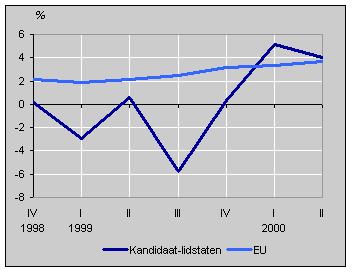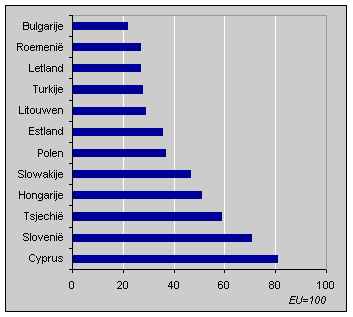Candidate countries for the European Union

At the EU top in Nice earlier this month, European leaders agreed on a number of measures to improve European Union government procedures with the expansion of the EU in mind. The statistical office of the EU compiles figures on a group of EU candidate members: Bulgaria, Cyprus, Estonia, Hungary, Latvia, Lithuania, Malta, Poland, Romania, Slovenia, Slovakia, the Czech Republic and Turkey.
At 525 billion euros, the value of the gross domestic product (the sum of all goods and services produced in a country) in the future EU member states is the equivalent of 7% of GDP of the present members, and about the size of Spain's GDP. In the Netherlands GDP was 374 billion euros last year, accounting for about 5% of the EU total.
From 1995 to 1999, economic growth was on average 1.5 percentage points higher in the candidate states than in the EU. Only in 1999 was growth in the future EU member states lower than the EU average. In the first half of this year the volume increase of gross domestic product (GDP) in the candidate states was 1 percentage point higher again than the EU average.
Economic growth

Per capita GDP is often used as an indicator of the relative prosperity of countries. To do this, GDP first has to be corrected for differences in price levels between the countries, which is done with the aid of purchasing power parities. In 1999 GDP per capita in the candidate member states was highest in Cyprus and lowest in Bulgaria. For all the candidate members together, per capita GDP is one third of the figure for the EU.
GDP per capita 1999, purchasing power parities

Frans van Ingen Schenau